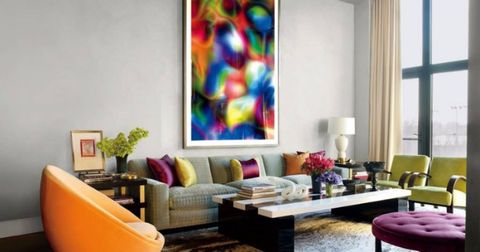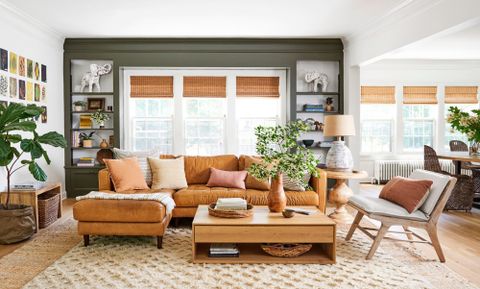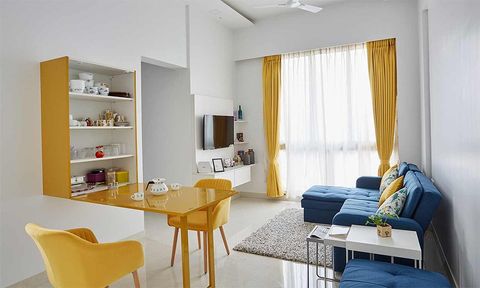When designers tackle a living room project, they don’t just think about aesthetics. They analyze every dollar like a financial planner, weighing each purchase against its long-term impact. What seems like a simple sofa becomes a complex decision involving durability, resale value, and space efficiency. This isn’t about being stingy – it’s about making choices that maximize both beauty and practicality.
Imagine walking into a living room that feels perfectly balanced – not too crowded, not too sparse, with everything serving a purpose. Now picture the designer who planned it all. They didn’t just pick pretty things. They calculated. They researched. They made decisions based on what would last and what would bring joy. Every dollar spent was intentional. Every item chosen had a reason behind it. This isn’t some designer fantasy – it’s how professionals actually work. They understand that living rooms aren’t just spaces to decorate. They’re investments in daily life. So how do they really think about money when planning?
The Foundation: Setting Realistic Expectations
Before any dollar hits the table, designers start with honest conversations about what’s possible. They ask questions like: ‘What’s your budget range?’ ‘How much time do you want to spend on this?’ ‘Do you want to do everything yourself or hire help?’ These aren’t just casual questions. They’re the foundation for everything that follows.
Let’s face it, most people have grand visions for their living rooms. But when you’re working with a specific amount of money, reality sets in quickly. A designer might suggest: ‘If you’re looking at $5,000, focus on the big pieces first – the sofa, coffee table, and main seating arrangement.’ Why? Because these items define the room’s personality and function.
Consider this scenario: Someone wants to spend $3,000 on a living room. A smart designer won’t tell them to buy everything new. Instead, they’ll say: ‘Start with what you absolutely must replace. Maybe the old sofa is worn beyond repair. That’s your priority. Then look for secondhand finds that match your style.’
The key insight here is that most people overestimate how much they can get done for a given amount of money. Designers know better. They’ve seen countless projects go sideways because someone thought they could afford everything they wanted.
The Big Three: Priority Items That Matter Most
Designers always start with what they call the ‘big three’ – the three essential pieces that define the room’s character. These aren’t necessarily the most expensive items, but they’re the ones that everyone sees and interacts with daily.
The sofa is usually number one. It’s where people sit, watch TV, and gather. A good sofa can last 15-20 years if properly cared for. That’s a long time to be happy with your choice. Designers often recommend spending 40-50% of your total budget on the main sofa.
Next comes the coffee table. This item sits at the heart of conversation and functionality. It’s where phones go, drinks rest, and books pile up. The right coffee table can tie together the whole room’s aesthetic.
Finally, there’s the primary seating arrangement. This includes any additional chairs or armchairs. These might seem less important, but they’re crucial for comfort and social interaction. They also set the stage for how people move through the space.
Think about it this way: If you’re designing a living room on a tight budget, you might choose to spend your entire budget on these three core elements. Everything else – decorative accessories, lighting, artwork – comes later. This approach ensures that the most important aspects of the room are well taken care of.
Some designers even suggest starting with a single piece that you love. If you find the perfect sofa for $800, that’s your anchor. Everything else builds around that foundation.
Smart Shopping Strategies
Here’s where designers really show their skills – in shopping. They don’t just wander through stores. They plan visits, research prices, and know exactly what they’re looking for.
One common strategy is to shop during sale seasons. Designers know that furniture stores often offer deep discounts in spring and fall. They also understand that major retailers have end-of-season clearance events. These can save hundreds or even thousands of dollars on quality pieces.
Another tactic is to blend new and used. Designers often recommend finding quality pieces at thrift stores or estate sales. For example, a beautiful wooden coffee table might cost $200 at a local antique store instead of $800 at a retail outlet. The key is knowing what to look for.
Consider the concept of ‘investment pieces.’ These are items that will remain stylish for years and hold their value. A classic leather sofa, a well-made dining table, or a statement chandelier are examples. These pieces are worth spending more on because they’ll serve you for decades.
On the flip side, there are ‘consumable items’ – things that change with trends and seasonal preferences. Throw pillows, wall art, and decorative objects fit this category. These are great places to stretch your budget further because they’re easy to update.
Designers also emphasize the importance of comparing prices across multiple channels. Online retailers often offer better deals than brick-and-mortar stores, especially for smaller items. But don’t forget to factor in delivery costs and return policies when making your final decision.
The Power of Color and Scale
This might sound counterintuitive, but color and scale are huge budget considerations for designers. The right palette can make a small room feel larger and more expensive, while poor choices can make even a large space look cheap.
A designer might suggest using a neutral base with one bold accent color. This approach allows you to spend more on the accent piece – perhaps a vibrant throw pillow or colorful artwork – while keeping the rest of the room simple and affordable.
Scale matters too. An oversized chair in a small room looks wrong and expensive. A tiny table in a large room feels lost and cheap. Designers spend a lot of time ensuring proportions work correctly.
Let’s talk about texture. Adding texture through fabrics and materials can dramatically improve a room’s appearance without breaking the bank. A chunky knit throw can transform a plain sofa, while a beautiful area rug can anchor a room and make it feel more complete.
Sometimes the best design moves are the simplest. A designer might recommend painting an existing piece rather than buying something new. Or choosing a simple, timeless shape over something trendy and expensive. These choices might save you hundreds of dollars while still achieving a stunning result.
The key lesson here is that good design isn’t about spending the most money. It’s about making the most of what you have.
Making the Most of Secondhand Finds
Many designers consider secondhand shopping a secret weapon in their arsenal. It’s not just about saving money – it’s about finding unique pieces that perfectly fit your style and budget.
The trick is knowing where to look. Designers often frequent local estate sales, antique shops, and online marketplaces. They understand that the best finds come from unexpected places. Sometimes a $20 chair from a garage sale can become the centerpiece of an entire room.
Quality matters more than age. A well-built wooden table from 1970s might be more solid than something you’d buy today. The key is looking for structural integrity and good craftsmanship.
Designers also appreciate the stories behind pieces. A vintage lamp from a grandmother’s attic might have more character than a new one from a showroom. These items often add warmth and personality that mass-produced goods simply cannot match.
There’s also the element of surprise. When you’re shopping secondhand, you never know what you might find. One day you’re looking for a coffee table, and the next you discover a stunning vintage mirror that transforms the whole room.
The process requires patience and a willingness to see potential where others see flaws. But for those who master it, secondhand shopping can provide incredible value and unique pieces that reflect personal taste.
Avoiding Common Budget Traps
Even the most careful designers can fall into budget pitfalls. Recognizing these early can save you hundreds or thousands of dollars.
One common mistake is trying to do everything at once. People think they can redecorate an entire living room in one weekend. Reality check: This approach often leads to overspending and poor decisions. Smart designers recommend tackling one area at a time.
Another trap is falling for ‘everything must be new’ thinking. This mindset pushes people toward unnecessary purchases. Many times, a few carefully chosen new items can completely transform a space without requiring a full overhaul.
The ‘trend trap’ is also dangerous. Designers see this constantly – people buying items because they’re trendy, not because they suit their lifestyle. A trendy piece might look great now, but it could be outdated in six months. That’s not just bad design – it’s bad investment.
Also watch out for the ‘perfect solution’ mentality. It’s tempting to believe that spending more money will solve every problem. But often, the best solution is a clever arrangement or simple adjustment rather than another expensive purchase.
Finally, don’t forget to account for hidden costs. Delivery fees, assembly charges, and even painting can add up quickly. Designers always factor these into their budgets, so you should too. These extras can easily consume 10-15% of your total project cost.
Long-Term Value vs. Short-Term Satisfaction
This is where designers really separate themselves from the average person. They think about the future as much as the present. What happens when your kids grow up? What about when your tastes change? How will this room age?
A designer might recommend a slightly less exciting but more durable piece over a flashy alternative. They understand that a well-made, classic chair will be comfortable for decades, while a trendy one might break down after a few years.
Consider the concept of ‘enduring style.’ Some pieces, like a good leather sofa or a beautiful wooden table, will look good in any decade. Others, like bright patterned cushions or modern minimalist decor, might date quickly. Designers help clients choose pieces that will stay relevant.
The emotional aspect is also important. A room that makes you happy and comfortable is worth more than one that looks impressive but feels cold. Designers balance aesthetics with practicality, knowing that the best designs are those that people love to live in.
Sometimes the most valuable purchase is a piece that’s just a little bit better than what you expected. It might cost a bit more upfront, but it will give you years of satisfaction. Designers know that investing in quality often pays dividends in happiness and longevity.
Remember, the goal isn’t to create the most expensive room. It’s to create the most satisfying one.
When designers approach living room planning, they don’t just see dollars and cents. They see lives, memories, and daily experiences. Every purchase is a decision about how you want to live in your space. They think strategically about budget allocation, knowing that some items deserve more investment while others can be more flexible. The key takeaway is that successful living room planning isn’t about having the most money – it’s about making the most of what you have. Whether you’re working with a modest budget or a generous one, these principles help you create a space that’s both beautiful and functional. The best living rooms aren’t built with the biggest budget – they’re built with the smartest thinking. So the next time you’re planning your living room, remember that the most important investment you can make is in thoughtful decision-making.














